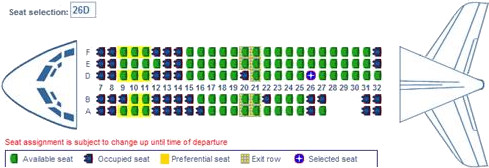Last week, I had a discussion with one of the companies developing online (travel) booking technology, followed by an exchange with one of the techies at the TMC, the travel management companies. The latter you can still call corporate travel agency, just a new name for old (and useful) business. It triggered some memories. And questions.
Back in 1995/96, I was the GDS expert behind the development of the first corporate web-service allowing to book flights using the Amadeus GDS. Facing the “it’s impossible” from the GDSs. Using screen scraping where today’s players have the luxury of APIs. The pioneering days and I miss them. Back in those days, I had an example I use in my discussions to date talking about “change management”. The technology did not trigger much interest. The break-through was a function I fought for, which my boss and the head developer disqualified as “toy”: The seat map.

To be able to select and see “your” seat is to date one of the most used (usually the most used) optional functions travelers use when booking online. As in the example, the “default” often assigns you a seat in the rear of the cabin, while you may (as many business travelers) want to sit up front. But. To date, only very few airlines show the seat map in the process, it’s still mostly a “click here”. And none of those nice tools uses the traveler preference to pre-assign the seat intelligently following the interest of the traveler. My preference is aisle, up front. if possible the seat next to me not being used. If the flight shows full empty like the above example I travel with Yulia, I book A/C, with the kids I book A/C+D/F, so leaving the middle seat intentionally free. If the flight is full, I try the same, as far back as I can. Because if they need to sit in the middle, travelers prefer to do so up front… Logic rules in fact, but not one of the systems implemented such an auto-selection, so I keep using the seat map and keep being upset about the seat I should have swallowed from automatic assignment…
 Now last weekend a post emerged about kids-free zones, just triggering the question, why those systems to date cannot manage prioritized seating. Exit rows and seats meant for baby bassinets or passengers needing extra assistance (for medical, not for financial reasons) are sold at premium charge, where they were blocked to gate assignment in the past (for good reason). Families struggle to be seated together when all the seats have been pre-reserved. Passengers arguing when they loose their early booked “nice” seats in the process, ending up on the least-preferred middle-seats. And none of the airline systems has a process in place to automatically reassign such seats in advance of the flight. So much that could be done to improve the process, but the systems, even the airlines’ own still are down to the pre-Internet management of seats on the GDS/CRS.
Now last weekend a post emerged about kids-free zones, just triggering the question, why those systems to date cannot manage prioritized seating. Exit rows and seats meant for baby bassinets or passengers needing extra assistance (for medical, not for financial reasons) are sold at premium charge, where they were blocked to gate assignment in the past (for good reason). Families struggle to be seated together when all the seats have been pre-reserved. Passengers arguing when they loose their early booked “nice” seats in the process, ending up on the least-preferred middle-seats. And none of the airline systems has a process in place to automatically reassign such seats in advance of the flight. So much that could be done to improve the process, but the systems, even the airlines’ own still are down to the pre-Internet management of seats on the GDS/CRS.
October 6th, easyJet promoted:

262 days. Triggering my comment “Sometimes I miss the good old days when we argued why flight bookings should be expanded from 330 to 360 days… And wondering why the “newcomers” did never invent a possibility to even “waitlist” beyond. Why not?” Because the brunt of bookings comes in short notice, it’s only a niche, flight plans change, it’s the way it is… Yeah, I know all those meak, user-ignorant reasons. And yeah, I keep asking the question. A “wait list” is no guarantee you get what you want. It’s an expression of interest, if you fly, I want to fly with you…
Another “logical question” is the user-centric implementation of the process. Discussing the issue of “virtual agents” and online support chat, one of the very early discussions I had with my friend Alex was the question to understand, when the virtual agent reached it’s limit and to redirect the discussion to a real agent… Alex is a former colleague I very much like; he was the master mind behind Virtuoz virtual agents (around 2002), speech recognition (2013), which Facebook acquired 2015 and today he’s one of the parents of Facebook M, the artificial intelligence development at Facebook.

Flight bookings are still the core of “online travel booking”, followed by hotels, travel expense, rental cars or rail. But to date, the complexity of air travel limits those tools mostly to be useful for simple bookings like A to B and back. Nevertheless, since my days (~15 years ago), the processes to request more complex flights are there. Fill out a form, the system runs a “best price” and that’s it. 15 years ago, a friend of mine being VP IT at one of the TMCs and I defined over some lunch meetings a process to split the process in such case, create the PNR with the request, the recommended flights and send it to a travel agent for a required review. Because in these cases, any experienced travel agent with their business intelligence can really “do” something, make the booking much better fitting to the need of the traveler. Today, the process exists, but split completely. All bookings go via messaging and are manually processed by a travel agent (I had that at SITA, being one of the global tech-leaders …), or book online. But that’s optimized to the existing corporate and travel agency processes, it is not user centric. 15 years after I moved on.
The only “major” changes are the integrated travel expense reporting we also started already back then and some minor improvements on the part of flexibility in the travel approval process. All else: Minor minor. Very small. In my view simply limping behind on industry developments, forced by increased differentiation, i.e. on airline’s ancillary revenues (ooops… buzz word…). Having a look at what we have today, speaking with the makers of these technologies, I’m sorry, but in my opinion, they stalled. The fun of the pioneering days is over, now changes are very, very little, incremental and it’s mostly fixating the existing processes.
What do you think?
Food for Thought
Comments welcome!
![“Our Heads Are Round so our Thoughts Can Change Direction” [Francis Picabia]](https://foodforthought.barthel.eu/wp-content/uploads/2021/10/Picabia-Francis-Round-Heads.jpg)